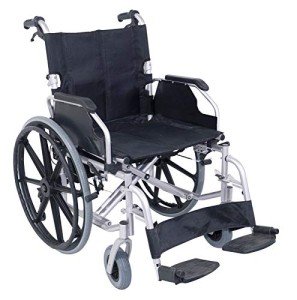Bariatric Wheelchair Seat Width
Seat Width
Having the appropriate seat width is crucial to wheelchair users who invest longer durations in their chairs. Too narrow a seat will cause pressure on the hips and thighs which might cause sores or pressure points. Having too large a seat can also make it challenging for the user to reach the hand rims to move themselves or maneuver in little areas.
To measure the right seat width an individual would sit on a chair generally and have their measurement taken throughout their lap at the largest point which is usually their hips. A wheelchair determining tape can be used to determine this, however a backyard stick is chosen as it avoids people from wrapping the tape around their hips which would provide an inaccurate outcome.
The standard wheelchair seat width is 16" (narrow adult), 18" (standard adult), and 20" (large grownup). For bariatric patients, a 24" seat is available. This sturdy extra large bariatric wheelchair from Medline features swing-away footrests, a carbon steel frame with rust- and chip-resistant chrome plating, and easy-to-clean vinyl upholstery. It has a weight capacity of 500 pounds.
Seat Depth
Typically, the seat depth of a bariatric wheelchair was included 2" to the measurement taken at the user's best point (usually their hips). This was meant to accommodate extra layers of clothing that might be used during winter. Nevertheless, this practice is becoming less common as wheelchair users have the ability to invest more time inside and are not using long coats. This makes the seat depth of a chair lesser when selecting a bariatric wheelchair. However, it is still crucial to pick a choice that offers appropriate support for bigger users.
The Medline folding extra wide bariatric manual wheelchair features a comfortable 24" seat width and a sturdy slide tube silver vein frame. It likewise has an adjustable axle and tool-free elevating legrests.
Seat Height
When it comes to identifying the right wheelchair seat width you need to constantly determine from the user's widest point which is normally their hips. You will also require to consider whether the user is going to be wearing a winter season coat as this might add 2" to the width required.
When a wheelchair remains in use it need to only be operated on level surface areas with the wheel locks totally engaged. This is to prevent the chair from having the ability to move slopes that are 10 degrees or higher. It is likewise essential to keep in mind that any activity that may move the center of gravity in the chair should be done with care. This includes reaching for items that require the individual to lean out of their seat or trying to stand up from it.

Whenever you have the chair in usage it is recommended that you frequently check it for damage and lubricate any areas that are considered needed. For bariatric wheelchair 22 inch , the casters should be lubed by removing the caster fork and using a multi-purpose grease to use to the caster stem bearings. Similarly, the foot plates can be changed by loosening up the bolt and then moving them to the desired position. bariatric wheelchair 26 inch seat permits the feet to sit easily on the footplate and avoids any pressure points from forming. This can be extremely uneasy for the user and if left unattended, can result in press sores.
Weight Capacity
Bariatric wheelchairs are created to support more weight than basic wheelchairs. This makes them stronger and better geared up to handle falls. They are also typically bigger and broader, making them less maneuverable in tight areas than basic wheelchairs. They require vehicles with special ramps and lifts to fill them, along with chauffeurs who know how to finest transport them from one area to the next.
When picking bariatric wheelchair 26 inch seat , consider its weight capacity as it will be the main determining aspect in whether it will accommodate your passenger's needs. The weight capacity of the chair is typically listed as a static load, meaning that it indicates the amount of weight the chair can easily hold while standing still. Nevertheless, some manufacturers also list an active load that is based on a drop test and can simulate the result of somebody sitting down in the chair. This may be a more reliable measurement of the weight limit, depending upon your requirements.
If you prepare to carry out activities that shift your center of gravity in the seat (such as grabbing items), make sure to have front casters pointed in a forward direction and wheel locks engaged so the chair will not topple. Also, check that casters are oiled routinely to prevent extreme wear and abrasions. The lubrication treatment includes getting rid of the fork, separating the caster from the wheel, and greasing the caster stem bearings with high-quality multi-purpose grease.
